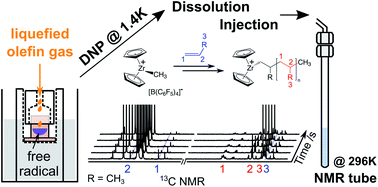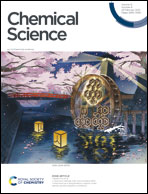Polyolefin catalysis of propene, 1-butene and isobutene monitored using hyperpolarized NMR†
Abstract
Polymerization reactions of the dissolved gases propene, 1-butene, and isobutene catalyzed by [Zr(Cp)2Me][B(C6F5)4] were characterized using in situ NMR. Hyperpolarization of 13C spins by the dissolution dynamic nuclear polarization (DNP) technique provided a signal enhancement of up to 5000-fold for these monomers. For DNP hyperpolarization, liquid aliquots containing monomers were prepared at a temperature between the freezing point of the solvent toluene and the boiling point of the monomer, mixed with the polarizing agent α,γ-bis-diphenylene-β-phenylallyl free radical, and subsequently frozen. The hyperpolarized signals after dissolution enabled the observation of reaction kinetics, as well as polymer products and side products within a time of 30 s from the start of the reaction. The observed kinetic rate constants for polymerization followed a decreasing trend for propene, 1-butene, and isobutene, with the lowest rate constant for the latter explained by steric bulk. For all reactions, partial deactivation was further observed during the measurement time. The line shape and the chemical shift of the monomer signals with respect to a toluene signal were both dependent on catalyst concentration and reaction time, with the strongest dependence observed for isobutene. These changes are consistent with the characteristics of a rapid binding and unbinding process of the monomer to the catalyst occurring during the reaction.



 Please wait while we load your content...
Please wait while we load your content...